
Very early in my career, an experience with Mr. Chandrasekhar (General Manager) of Higginbothams Bookstore in Chennai, taught me the importance of being mindful of one’s conduct as reputation takes a long to build and can be destroyed in an instance.
Year 1994, as a 27 year young executive with a multinational, I was based at Chennai (India), responsible for forging business alliances with local establishments. Mr. Chandrasekhar had proved to be impossible to meet by any of my predecessors. Going by the laws of probability, one would be better off not concentrating energy on him.
One day, I still chose to walk into his office and presented my visiting card to his secretary. At that very moment, Mr. Chandrasekhar was rushing out of his office and we exchanged a momentary glance. I sensed a positive energy in his smile. Thirty minutes later, I was inside his office and surprisingly the business agreement was signed in that single meeting.
I could not understand why my predecessors had failed. Few months later, in a follow up meeting, I asked Mr. Chandrasekhar why for years he had refused to meet representatives from our company, while with me he had made the entire engagement so smooth.
He replied, “At the age of 20 years, when I first travelled to Delhi from Chennai, my mothers only advice was that on getting down at New Delhi railway station, I should not talk to any stranger and proceed directly to the taxi stand to engage a Sikh taxi driver to get me to the hotel.”
So what does that have to do with him having been so receptive to me?
I soon realized that he was following his heart as ingrained by his mother about the image of trustworthiness and honesty. That’s a lot of blind trust placed on an entire community.
From that day, I became mindful that my actions should never marginalize the years of reputation built by elders of my community.
Fast forward to October 2013, I was approached by two youngsters in Singapore, Ishvinder Singh (Ish) and Vithya Subramaniam (Vithya). They wanted me to partner to photograph statues of Sikhs guarding the graves of Chinese people at Bukit Brown Cemetery.
Background to Bukit Brown Cemetery : A large land size, smack in the heart of Singapore island, houses over 100,000 tombs of Singaporean Chinese. It was opened in 1922 by Municipal Corporation and has been abandoned to nature since 1973. In the cemetery there are nearly 50 tombs with statutes of Sikh soldiers guarding them. The count of 50 is not official as graves tucked in the lap of natural vegetation continue to be discovered and the terrain in some areas is hard to navigate. In September 2011, the Land Transport Authority (LTA) announced the construction of a new road that would cut through Bukit Brown, effecting about 5,000 tombs. Fearing further development in the future, many groups have been rallying to “Save Bukit Brown Cemetery”, calling for preservation of a century old site.
Ish expressed to me, “In 2011, when the government announced that a part of Bukit Brown Cemetery was to be re-claimed for a highway, I was not too concerned. Bukit Brown did not matter to me because the Chinese culture was foreign to me and I had no intentions of messing with the supernatural. Until one day on Facebook, I noticed a bunch of turbaned and bearded statues appear on my screen that looked so much like me! These were the Sikh statues of Bukit Brown and more than 24 pairs of them had been re-discovered by Mr. Peter Pak who had documented them on his blog. I was struck by the careful detail of the turban, handcrafted curl of the beard and the crafting of the Sikh Kirpan (ceremonial sword). I fell in love with Bukit Brown. I soon found myself rallying around the ‘Save Bukit Brown Cemetery’ campaign, feeling that this place mattered to me.”
Ish’s engagement as a turbaned Sikh in the protection campaign was spotted by TEDxYouth@SG and he was invited to speak in the local youth chapter. Vithya’s previous trips to the cemetery abandoned to nature and in grip of vegetation making it tough to navigate in certain areas, made her a valuable partner in spotting tombs with statues of Sikh guards. The duo-team complemented well and they needed in me a mentor, someone with an experience in exploration and photography.
The personal identities of Sikhs and Chinese, intermingling to form a collective identity of Singapore in the Bukit Brown Cemetery is reflective of the diverse history of this small island nation.
Sikhs hail from Punjab. Indu (old name of India), the land mass on East of river Indus, a resource rich nation, attracted invasions by Central Asians via Afghanistan to loot, plunder and rule. Trend of repeated attacks since 9th century was only reversed in 18th century, when Sikhs succeeded in forming their own kingdom and sealing advances into India. While Punjab was secured by Sikhs, the British had succeeded in expanding their rule elsewhere in India between 1778 – 1845, with territory of British India stopping where the boundaries of Sikh kingdom started. Between 1845 – 1847, the two Anglo-Sikh wars led to annexation of Punjab and the Sikh kingdom into British India. The valor of Sikhs in these two wars did not go unnoticed. Thereafter, British started recruiting Sikhs as military and police personnel to be posted within India and in countries under rule of the crown.
The British recruitment handbooks stated : “the Sikhs displayed masculinity, [were] fairly un-corruptable and made good policemen.” (Reference R.W. Falcon’s)
The British reinforced adherence to the Khalsa (Sikh baptism lifestyle) identity through their recruitment policies. Only turbaned and bearded men of certain height and weight were accepted into the ranks. It was also made mandatory to maintain a turban and beard during the entire service period. British recognized that in the Sikhs belief of Khalsa tenets, lies their sense of discrimination between right and wrong, making them warriors of no match. As such, military service became a domain that could produce and police the British vision of a coherent Sikh identity.
The Sikhs first came to Singapore in 1819 as military and police personnel of the British East India Company. In 1881, the Sikh Police Contingent (SPC) was established in Singapore. The SPC was highly regarded by the British and were deployed to various states in Malaya. The SPC was disbanded at the end of World War II in 1945 because of the role of Sikh policemen and military personnel in partnering with Japanese, under the umbrella of “Azad Hind Force” to march into India and free it from British rule.
Not all Sikhs in Singapore found work as British policemen and military personnel as there were stringent recruitment requirements. Those who could not find employment in the colonial police forces found work as security guards and watchmen for private employers. So strong was the image of trustworthiness and honesty of the Sikhs that Chinese businessmen were known to entrust their family’s entire security to Sikh bodyguards. The Sikh watchmen were known as jagas (Malay word for “guard”) and they could be found guarding banks, godowns, major stores and school compounds.
It is with this background that one needs to see why some Chinese businessmen on death of their family members, felt the need to erect statues of Sikh bodyguards. Standing alongside other statues of Chinese Gods and angels, it is a testimony of the image of the Sikhs. The Sikh guards are not just security guards at these graves. Instead they are elevated to guardians of afterlife.
So strong was the impact and imagery of Sikhs that one Chinese businessman had also erected two large statues of Sikh bodyguards at the entrance of his residence. The picture below is from Singapore archives, clicked in 1939, showing two Sikh statues at the entrance. This house does not exist in modern Singapore.
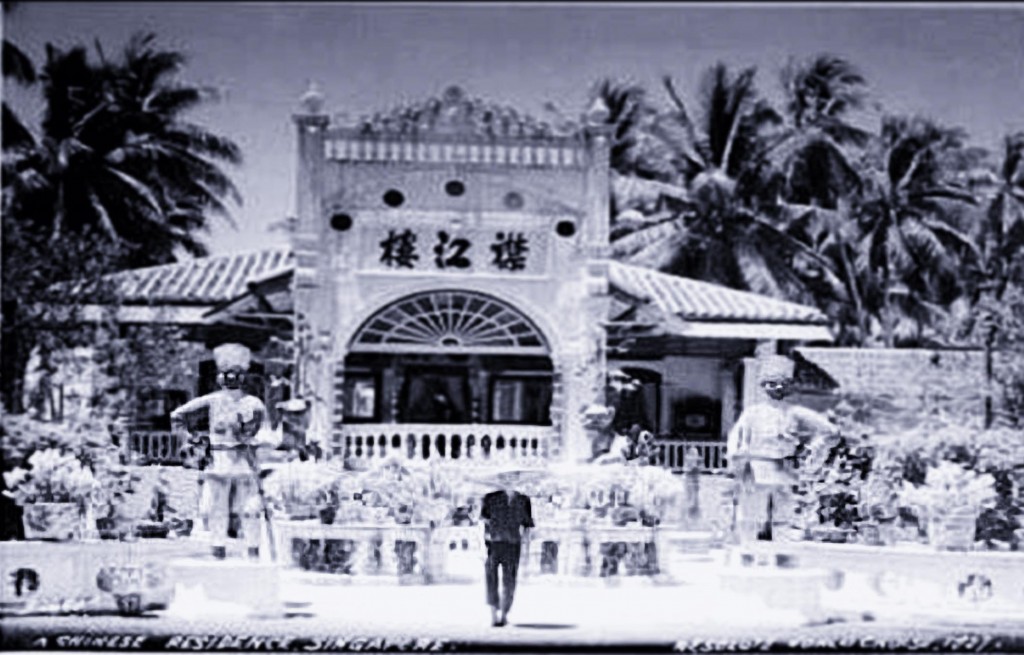
This has been a fun project to work with Ish and Vithya. While we have only succeeded in photographing 8 tombs with Sikh statues but there are many more to be discovered and photographed. Fortunately the Land Transport project, impacts only one grave with the Sikh statue, which will soon be exhumed. As some Singaporean Chinese continue to voice themselves under the banner of “Save Bukit Brown Cemetery”, I see an opportunity for the Sikh community to come forward and also voice the need to protect this heritage site. This would truly reflect the intermingling cultural history of this nation.
In order to continue with the project to photograph all the graves with statues of Sikh bodyguards, I encourage the youth of Singapore Sikh community to form a team with Ish and Vithya to help identify the graves so I can continue to photograph them professionally.
Bukit Brown Cemetery is a shared heritage indeed.
More importantly, Bukit Brown Cemetery reminds us the importance of being mindful of our daily conduct as over time it creates a reputation.
Indeed, reputation does follow to the grave!
Click first photo below and scroll to view series in large size.
The team that made this project possible :
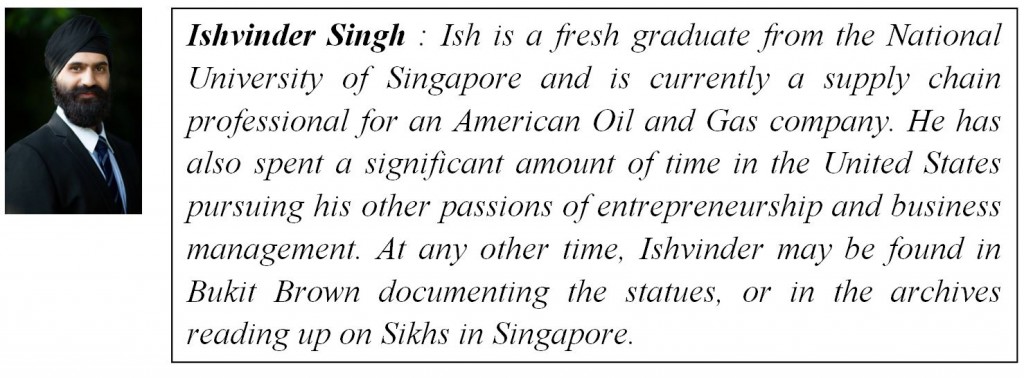
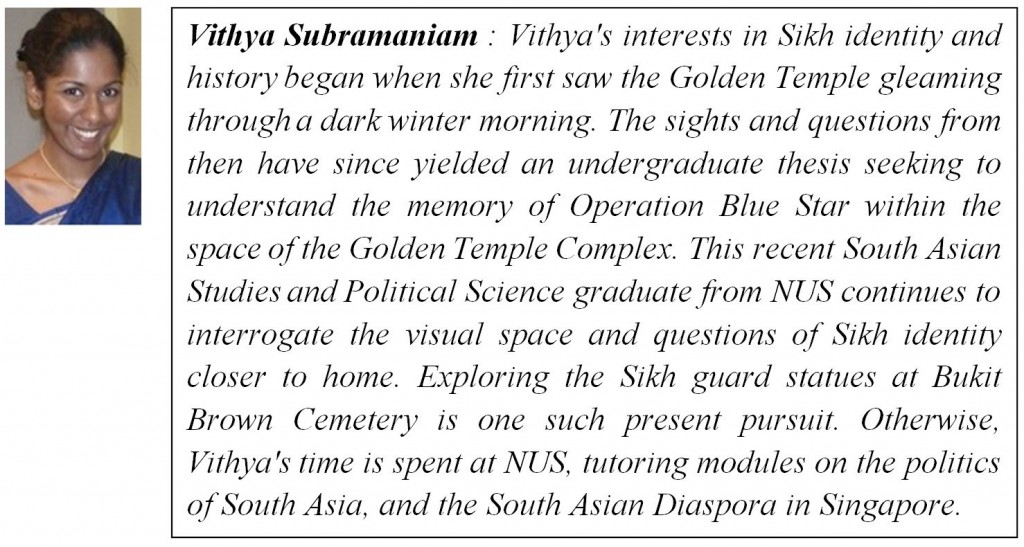


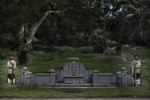
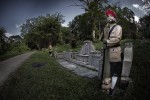


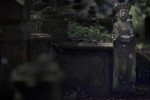


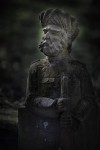

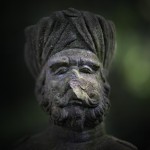
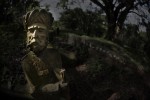
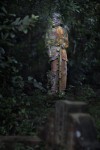

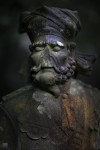

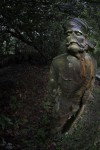
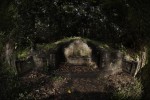

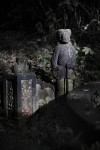

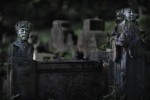

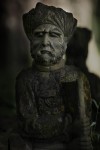
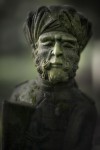




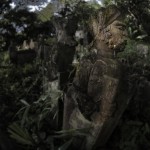
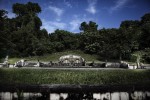
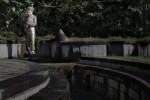
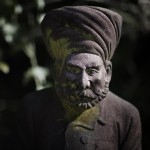


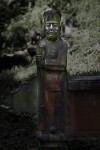



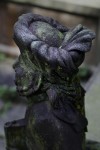
Comments(44)
Amit says:
November 29, 2013 at 4:44 PMSuperb writeup Amardeep – The reputation of sikhs is really something to be proud of …On a personal basis I have experienced the kindness from Sikhs while struck in a road accident(thankfully no harm) when no body else would stop ..
Dhruv Jolly says:
November 30, 2013 at 4:21 AMJust Beautiful and an amazing writeup … Great history of a great race … Great Learning … 🙂
Dhruv Jolly says:
November 30, 2013 at 4:53 AMDear Amardeep,
Now having gone through all the images, one feels that the Sikhs, with their nose broken … etc have in reality been vandalised ( somewhere in the past ). Reminiscent of when India was taken over and being explored by the Western Powers, who went about breaking limbs and defacing statues and architecture, at many temples and elsewhere. This is what comes to mind and most importantly that, this is a very potent part of cultural History, Travel , Human Perseverance and Journey. Thus must be preserved at any cost.
I hope that I would be able to be of some to help preserve this Heritage.
I have put your Blog all over my Batch and School Site for all Alumni to Read.
Kind Regards,
Dhruv
Thanks,
Tom Bodley says:
November 30, 2013 at 8:42 AMDear Amardeep – Reading this wonderful article and viewing the photos provided a most welcome insight into an important part of Singapore heritage. Very well done!!
Balvinder says:
November 30, 2013 at 4:37 PMDear Amardeep, great research and facts hitherto unknown to me and many others. Thank you for sharing and your courage in delving into the history and culture of a nation that continues to evolve rapidly losing perspective of its origin and of communities that have chosen to call this home.
Jag says:
December 10, 2013 at 5:00 PMIs this Balwinder Singh (Ex-Combat Engineers Gilman Barracks)?
Claire says:
December 1, 2013 at 3:58 AMHi, Bukit Brown is now on the World Monuments Watch List 2014. Please join our campaign to preserve our precious history. We are all stewards of our shared heritage. http://www.wmf.org/project/bukit-brown
Join the volunteers, who call ourselves Brownies, and walk down history with us.
Col Sarabjit Singh says:
December 1, 2013 at 4:06 AMHi Amardeep,
An excellent read, with truly beautiful pictures of the Sikh guards at the Bukit Brown Cemetery. A lot of hard work has gone in to save the cemetery from annihilation and bringing about the closeness amongst the Chinese and the Sikhs and universal faith in the sincerity of this brave and honest community.
Col R. K. Verma, Retd says:
December 1, 2013 at 12:25 PMSikhs have been one of the best soldiers in this world. My respect for them increases whenever I read their history.
India would have been a great country today and on top of the world if we Hindus had simply followed the philosophy & teachings of the Great Guru Nanak. I have always found peace & tranquility whenever we visited any Gurudwara.
My salute to the Sikh community.
Col R. K. Verma, Retd says:
December 1, 2013 at 12:30 PMI am in Singapore these days and would be happy to learn more about Sikh History. Any suggestion ?
Ishvinder Singh says:
December 5, 2013 at 11:10 AMHi Col R.K Verma,
There is a Bukit Brown Tour taking place this Saturday, 7th December at 9am, dedicated to the Sikh Statues.
Do drop me an email at ishvinder87@gmail.com for more information.
Rdgs,
Ish
Harpal Singh Panesar says:
December 1, 2013 at 9:01 PMVery interesting bit of sikh history. Being a part of the sikh diaspora my own observation is that sikhs have got on well with whatever community we are settled among. In the process we have earned their respect. This revelation of Sikh Chinese interaction reflects this only goo well. Similarly Sikhs within East Africa have too had such connections with the indigenous population ever since the building of the railways early last century. A lot of sikhs were brought over to build the railways. Many remained to help build the East affican nations. Imparted their skills to the locals and in so doing earned their respect. Sikhs all over the world have similar stories.
Salute to you all for researching and bringing the history of Bukit cemetery to add another feather to ghe olourcul sikh histofy
Balaji Kartha says:
December 1, 2013 at 10:28 PMI am a south Indian settled in Chennai and I went to a military school in Dehra Dun in the north. My first impressions of Sikhs was very strange. They had long hair like girls and tied a very elaborate headgear (which I would help make the pleats for).
However my own experience with Sikhs is mixed. I was once saved by an old Sikh auto driver in Delhi (around 1972/73 – on my way back from school) from definitely getting robbed (if not killed) by a gang of thugs in another auto. The gang in the other auto chased us and the old Sardar raced down the roads of Delhi cursing loudly till he found a police man. That was a very frightening experience for a 13 yr old and I am for ever in debt to Sardars for that; and then there was this Sardar senior of mine who broke by arm with a hockey stick for a stupid mistake of leaving my belt on the kit box during a dress parade! Never forgave that chap!
But I think they have a very unique religion which tells them to stand out in a crowd so as to attract all the fire in a battle – so that they can save the others! They are always told to expect violence against them and to react with courage. They have always to carry a sword – and it is not to initiate violence but to defend the weak (Hindus!).
Their stories (and history) are amazing.
Mandeep Singh says:
December 3, 2013 at 12:11 AMIts an outstanding team work….. thnx for providing us such g8 knowledge….. keep up……//
Arjit Mahal says:
December 3, 2013 at 12:13 AMDear Amardeep – You and your colleagues have done a great job in uncovering this unknown part of the Sikh History. Please continue this “Sewa” to the human cause through stories that inspire. It would be great for some institute in Singapore to preserve these statues. It would also make a nice Coffee-Table book. Best wishes
TJ Singh says:
December 3, 2013 at 2:40 AMGreat Job, you confirmed what was told to us by our Uncle, traveling extensively in Singapore and Malaysia in the fifties and sixties.
Alas!! our young Sikhs in India and Abroad will take inspiration from it
and Live by the rules established by 10 Gurus.
Keep up the good work!!
Maj Gen R S Phagura says:
December 3, 2013 at 1:43 PMHi Amardeep,
A very interesting piece of unknown history of the Sikhs.
Researching the Military History of India for the past one millennium,it was strange to discover that the Indians did never stand and won a battle against the foreign foes whether they came from the Northwest or the South via the sea. Even those of the foreigners who after their victories made India their home, went down the same drain when faced with new assailants. So did the Afghans gave way to Mughals who in their turn gave way to the Western conquerors all of who were ultimately defeated by the British who ruled the whole sub-continent for a considerable time but never settled in India permanently.
My assessment is that it happened due to tropical climate of our country (incidentally, all tropics were colonized by Western powers from cold or temperate climes) combined with our benign culture. The tropical climate is associated with general ‘lack of energy’ amongst the population. This lack of energy is the route cause of the lackadaisical attitude, dishonesty of purpose, lack of perseverance, extreme tolerance and other such lamentable behaviors. That was why the British (even Alexander and later Muslim rulers too) recruited, for their armies, soldiers from colder regions of India such as: the Punjab, Jammu, Himachal, Uttaranchal and Nepal. These soldiers because of better health and energy were found more suitable for army service by the Britishers. Because of better energy levels, they were also more disciplined and loyal to a cause. They proved their mettle in wars fought by the British all over the world in the two great wars.
The question then arises that, if the people from Punjab were better soldiers, then why, in the first instance, they were defeated by invaders from the Northwest? My explanation for that was bad leadership of the Indians (including the Punjabis). Whenever they had good leadership (such as Guru Gobind Singh and Ranjit Singh), they defeated anyone who dared to attack them. Not only that, they established the mettle of their arms even in the heartland of the invaders. So did the Sikh Empire of Ranjit Singh extend into Northwest frontier areas.
In my opinion, the better character qualities were incumbent upon better energy which in turn emanates from better diet. Hence, the British army’s answer for their world conquering Indian army was: 1. Recruit from colder regions of India; 2. Give them good diet; 3. Enforce proper discipline; 4. Arm them well; and finally, lead them well. They succeeded immensely in that.
Randhir Phagura
Harpreet Singh Toor says:
December 4, 2013 at 1:20 AMReally an interesting piece of information. Though the Sikhs have been traveling around the globe for more than a century and have fought many wars, either for or against the British, still have to struggle to convince the rest of the powers/people who we are.
Col (Retd) P.P. TALWAR says:
December 4, 2013 at 10:29 PMHailing from Afghanistan, but my parents had come down, in business connection to Peshawar, now capital 0f Pakhtunkhwa province, Pakistan, I distinctly remember my childhood having seen Darbar Sahib, where holy Guru Granth sahib was kept in our house in one of the floors of our multi-storeyed building in Peshawar city. My maternal parents were all Sikhs. My mother used to recite the verses of holy Guru Granth Sahib daily. My father used to attend Darbar sahib in our house daily, morning and evening. Ours was an affluent business family in Peshawar , owning huge business set up, having links with Iran and all central Asian countries, right upto Russian border. We had our own Gurdwara in Peshawar city. My grand mother would not leave for India after the partition in 1947, unless holy Darbar Sahib was shifted in a separate Railway comprtment.Her demand was finally met.Having got commission in 1950 in the erstwhile RIA, redesignated as the Regiment of Artillery, I had served with Sikh gunners for a number of years. I can vouch that Sikhs are the best soldiers in the world, true to their marshal spirit.
Group Captain Tejwant Singh says:
December 5, 2013 at 1:46 AMDear Amardeep Singh,
Indeed marvelous. Keep up the good show.
It’s a fact that a good reputation takes long to establish and it takes just a second to demolish. I am reminded about an incident in New Delhi in 1992. I was driving through Chanakyapuri where all the Embassies are located and so is a College named Jesus and Mary for women. I saw a number young ladies with books in the hands waving me for a lift. I stopped and they got in. I said, “You should girls should be careful when you ask for a lift.” Their immediate response in Hindi, “But you are a Sardar.” I felt pleased because I had seen that there were many who willfully tried to malign the Sikhs in the eyes of the public during the unfortunate incidents of 1984.
What about Americans mistaking us for Muslim-terrorist? To educate them I have an ongoing blog http://dontmistamemeforamuslim.wordpress.com/ This is for information of all who visit this site because in small capsules I am trying to project the history our community.
Sat Siri Akal,
Tejwant Singh
Inderjeet Singh says:
December 5, 2013 at 5:55 AMUnique and beautiful. Thanks for sharing with us.
Charan Singh Kalsi says:
December 5, 2013 at 6:03 AMI have read all the comments and full article. I believe if any body can do the job then I can also do it. All the Sikhs must send out their kids for public service, so they can serve the public and get the recognition being a best Sikh and human being.
Thanks to all for the good work and making Sikh standard very high.
Sanjay Tamta says:
December 5, 2013 at 5:51 PMVery intensely described. I have just come to realize that Bukit Brown is a site which is up-hoisting Indian national pride. I wonder why it is not there in our school syllabuses, calendars, posters or any such literary/visual medium ???
capt naunihal singh says:
December 6, 2013 at 1:47 AMDear Amardeep -you and team have done great service to all-and pray u get success-and this reinforces faith go serve mankind/world to our best aptitude
Blessings
Capt Suresh says:
December 6, 2013 at 11:40 AMLoved every bit of it and admire your efforts and that of your friends. People like you make the planet a better place where people care for each other and respect others selflessly.
Capt Suresh says:
December 6, 2013 at 11:45 AMLOve the photos which have been done so very well with the magical light exploited to its best. Enjoyed viewing each one of the images here.
Bhupinder SIngh says:
December 7, 2013 at 1:42 PMDear Amandeep, What a wonderful article and photos! Thanks for the great work all three of you are doing. Best of Luck.
Bhupinder
Ranbir singh says:
December 8, 2013 at 6:33 PMDear Amardeep,
Kudos.A very well explained good research and wonderful photography.It is been very clear now a days that we really cannot hope anything from our sikh leadership to give a damn care for our great great history..and the way khalsa always stood to serve humanity in all the ways it can.
Thanking you for the great job done….and praying to the almighty one to keep you and your team in chardikala to keep your good work going.
Guru fateh..
Ranbir singh.
dr gp singh says:
December 8, 2013 at 11:20 PMExcellent article. Let all learn from this.
Gurb says:
December 10, 2013 at 8:44 AMExcellant research, Thanks, I suggest all Sikhs should visit Kranji War Memorial to see the
sacrifices made by the Sikhs in the second world war, defending Singapore And Malaysia
during the Japnese invation,. Singapore Sikhs should hold Prayers for all on the Memorial
Services conducted by the British High Commission Singapore, the next service will be
conducted on 4th November 2014. Payer should be followed by Langar for all.
Gurbachan Singh Sekhon
Johor Bahru Malaysia
Barathan N says:
December 11, 2013 at 11:42 AMThank you for your very insightful article.
One should build and safe guard his/her reputation and not let it his own demise.
People should learn to appreciate their fellow man’s existence and not take it for granted.
Barathan N
Singapore
Col SS MALHARI says:
December 12, 2013 at 11:23 PMKudos to Ishvinder Singh , Vithya Subramaniam and Amandeep Singh for bringing out the excellent SIKH history. May the ALMIGHTY WAHEGURU grant you strength and encourage you to discovery much more and enlighten us all.
Sat Sri Akal
Brig.S.S.VIRDI says:
December 13, 2013 at 8:32 PMDear Sir,
Indeed Sikhs have contributed a lot in Singapore. The very name of this erstwhile strategic British port Singapore – though presently linked with the word SINGH meaning a LION could also
be due to the immensity of inputs from the SINGHS(another
name for Sikhs and which is a suffix with every Sikh’s name)
The British thoroughly used the saint -soldier culture of the Sikhs in not only Police and Military duties at Singhapore but in the entire world specially in the 1914-18 Grreat War in Europe but in winning the World War 1939-45.Besides the Sikh troops were used by the British in the subjugation of the Afghans during their rule of India.The exceptional and extreme sacrifices and bravery of the Sikh troops are a part of
history. Singaporean Government of today should be made aware of theie history and the role of Sikhs in making it what it is today-a shining example of a prosperous state. Brig VIRDI
Jagjot Singh Nagra says:
December 20, 2013 at 3:35 PMDear Ish, Vithya and Amardeep,
Thank you for bringing such an interesting element of Sikh history to light.
The statues bring to light the justice done by the sikhs to their duty by living up to the values of their faith and also the respect, regard and reverence (all aspects of appreciation) shown to them by their Chinese masters.
My deepest respects to those Sikhs and Chinese of Singapore.
Regards,
Jagjot
inderjit gill says:
December 22, 2013 at 9:15 AMAmazing article ,pictures and research. I always assumed Sikh history with the Chinese was not very pleasant seeing some pictures and anecdotes from Sikh policemen in Shanghai and Hongkong . How did the British recruit Sikhs for Singapore in 1819? The annexation of Punjab was over 30 years away?
Amardeep Singh says:
December 22, 2013 at 9:43 AMSikhs were kept to enforce law and order across East Asia in places like Malaysia, Singapore, Hong Kong, China, etc. I don’t think the relationship between Chinese and Sikhs were strained, however they were definitely feared by locals on account of the power the policemen had and also for the unique appearance of the Sikhs. The also had a reputation of being trustworthy.
The British had started recruiting Sikhs in 1819 from areas in the East of river Sutlej, which was not a part of Maharajah Ranjit Singh’s empire.
Gurdeep singh Mehta says:
June 13, 2014 at 12:59 PMI am a sikh an ex army officer and had a privilege to command a company of SIKH LI troops and have many incidents where there honestly and loyalty were unmatched and the 5 years i served i learnt a lot from these troops and that very learning came in extremely useful during up and downs of my business. Some of my JCO had fought in the chinese war and were POW but were treated with full respect and rights as sikhs during the prison time.
Amardeep /ish and Vithya , you guys are doing an amazing Job . keep it up.
reg
garry
GIAN SINGH BAMRAH says:
June 13, 2014 at 8:56 PMIt is heartening to know that such a heritage exist in SINGAPORE. It well portrays the highiest degree of SIKH CHARACTERISTIC THE WORLD OVER.
This heritage must be preserved at all costs. I appreciate the work done by S. Ishvinder Singh, S. Amardeep Singh and Madam Vithya Subramanium. My Orgnisation is also doing and propagating HERITAGE WORK in AMRITSAR,PUNJAB, INDIA. That can be seen from my site : http://www.ramgarhiaheritage.org as given above. Thanks.
Bhupinder Sandhu says:
June 15, 2014 at 4:26 PMAn excellent article. This just shows how much the Sikhs have contributed around the world. Thank you to the great team work by Ishwinder Singh, Amardeep Singh and Vithya Subramaniun. Well done !
Regards
Bhupinder
Geetinder Singh says:
June 18, 2014 at 1:36 PMGreat job guys!
Thanks for introducing us to this gem of history.
col retired param jit singh pental says:
January 22, 2015 at 2:24 PMwonderful and unforgetable. I REALY FEEL GOOD AND PROUD OF BEING A SIKH
GOD BLESS U 4 DOING A PRODIGAL JOB,I COME FROM FAMILY OF BABA KHARAK
SINGH MY GRAND UNCLE WHO SPENT 28 YEARS IN JAIL TO GET INDIFENDENCE 0F INDIA .MY FATHER SARDAR NIRMAL SINGH AND MY TAYA JI ALSO SPENT ABOUT 5 YEARS IN JAILS 4 THE SAME CAUSE.
Maj Gen (Retd) PS Malhotra says:
January 24, 2015 at 8:35 AMDear Amardeep, Ishvinder & Vithya,
I am grateful to you all for bringing to us the details & history of Bukit Brown Cemetery.
I am a proud Sikh.
Carry on the good work.
Pareminder S Malhotra
ravinder singh bedi says:
January 24, 2015 at 6:11 PMSikh community has contributed so much to singapore and malayasia.But there is no detailed doucementation OF.the contribution made by this community to the history right from the time of GURU NANAK who visited a number of countries to the present date when sikhs have also contributed to the modern world.NOT ONLY ALL OUR THE WORLD BUT ALSO to india.
I was surprised to read that the NIZAMS of hyderabad had sought help from MAHARAJA RANJIT SINGH and sikhs had been sent hyderabad to help the NIZAM and their descendents are even now living in hyderabnad.WHAT is needed a comprehensive docementation of our very virile and hard working community.
Gill says:
November 21, 2015 at 9:06 PMI discovered some old Sikh statutes in our neighbors home in Gilstead Road today. The house is old and falling apart.